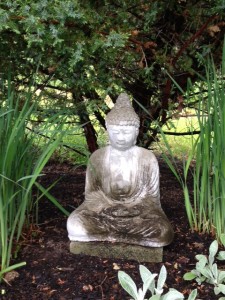Here is a simple, meditative way to start feeling the breath deep in the body. This sequence is an ancient meditative practice that I adapted from Dr. Andrew Weill.
1) Sit comfortably with your back long and supported. Both your legs can be crossed in front of you like in a typical meditation position, but not one leg crossed over the other, which inhibits circulation.
2) First, just notice how you are breathing. What moves in or out, up or down as you inhale and exhale? What does your body do to accommodate the breath? Do you have a hold or pause in your breath between the inhaling and the following exhalation or between exhaling and the next inhalation? Notice everything you can about how you breathe.
3) Now concentrate on the exhalation only. With every breath, invite it to gradually get slower, one or two ticks per breath, so that there is no strain, just an easy, comfortable, steady slowing down of the exhalation. Don’t worry about the inhalation. It will follow along. You may feel the actual exhalation happens less often and is slower than usual. Both are good. Do this until you feel you have reached your slowest comfortable breath.
4) Switch your attention to the inhalation. In the same gradual way, invite the inhalation to slow down a tick or two with each breath. Concentrate on the inhalation, letting the exhalation take care of itself. Notice how your body inhales, what expands or stays still? Let this be gentle and without strain.
5) Now watch both the slow inhalation and the slow exhalation. Invite the entire circle of the breath to slow down even more if it wants to. Just make the inner suggestion and watch what your body wants to do. If you are holding between either direction of the breath, see if you can allow the pause to remain open in the throat. A pause between the inhalation and the following exhalation and then again between the end of the exhalation and the start of the inhalation is normal. You don’t need to hold your throat, jaw, mouth or belly tight or closed in that transition point. The transition can feel like a swing when it rises to the apex of its arc, a natural suspension rather than having to do anything. Closing the throat inhibits the free breath and reinforces tension in the body. Notice and breathe, enjoying the deep massage of the breath and the stillness of being present in your own breath.


Speak Your Mind